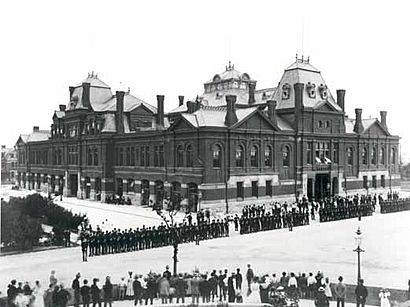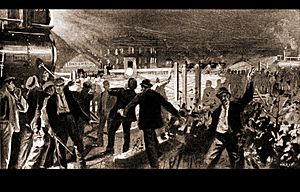Pullman Strike facts for kids
Quick facts for kids Pullman Strike |
|||
|---|---|---|---|

Striking railroad workers confront Illinois National Guard troops in Chicago during the strike.
|
|||
| Date | May 11, 1894 – July 20, 1894 | ||
| Location |
Began in Pullman, Chicago; spread throughout the United States
|
||
| Goals | Union recognition Wage increase Rent reduction |
||
| Methods | Strikes, Protest, Demonstrations | ||
| Resulted in | Strike unsuccessful
|
||
| Parties to the civil conflict | |||
|
|||
| Lead figures | |||
|
|
|||
| Number | |||
|
|||
| Casualties | |||
|
|||
The Pullman Strike was a major event in American history in 1894. It involved two main parts: first, a strike by workers at the Pullman factory in Chicago, and then a huge boycott across the country against trains that used Pullman cars. This event happened during a time when the economy was struggling.
The strike and boycott lasted from May 11 to July 20, 1894. It was a big moment for how workers' rights were handled in the United States. The strike involved the American Railway Union (ARU) and the Pullman Company, along with many railroads and the U.S. government led by President Grover Cleveland. This conflict stopped a lot of train travel for both goods and people, especially in the western parts of the country.
The trouble started on May 11 when about 4,000 workers at the Pullman Company stopped working. They were upset because their wages had been cut. Many of these factory workers lived in a special "company town" called Pullman, just outside Chicago. This town was designed by the company's owner, George Pullman, as a perfect community.
Contents
Why the Workers Struck
During a tough economic time in 1893, railroads stopped buying new passenger cars from Pullman. Because of this, the Pullman Company let go of many workers and lowered the pay for those who remained. However, the company did not lower the rent for homes in the company town. This made workers very angry.
Workers also felt they had no say in how the town was run. The company controlled everything, including high prices for water and gas. They also refused to let workers buy their own homes. At first, the workers did not have a union.
The American Railway Union Steps In
The ARU was a group for railroad workers, started in 1893 by Eugene V. Debs. Debs sent ARU organizers to Pullman, and many unhappy factory workers joined. The Pullman Company refused to recognize the ARU or talk about the workers' complaints. So, the ARU called a strike against the factory.
When the factory strike didn't seem to be working, Debs decided to try something bigger. He wanted to stop all trains that carried Pullman cars. This was a way to put more pressure on the company.
The Boycott Begins
Eugene V. Debs and the ARU started a huge boycott. This meant that ARU members refused to work on any train that had a Pullman car. This boycott affected most train lines west of Detroit. At its peak, about 250,000 workers in 27 states were involved.
Other labor groups, like the American Federation of Labor (AFL), did not support the boycott. They worried the ARU was trying to take their members. The powerful railroad groups for conductors and engineers also opposed the boycott. Railroad companies worked together to fight the boycott.
During the conflict, about 30 people were killed in Chicago. Historians believe another 40 people died in other states. There was also a lot of damage to property, costing over $80 million.
Government Steps In
The U.S. government got involved to stop the strike. The Attorney General, Richard Olney, who had worked for railroads before, asked a court to issue an order against the union. This order told Debs and other union leaders to stop interfering with trains, especially those carrying mail.
When the strikers did not obey the court order, President Grover Cleveland sent the U.S. Army to Chicago. Their job was to make sure trains could run again. Violence broke out in many cities as the Army tried to enforce the order.
Debs had hoped the Army would help keep the peace, but they were there to make sure trains moved. This weakened the boycott. Thousands of U.S. Marshals and 12,000 U.S. Army troops worked to break the ARU's efforts. President Cleveland said he had to protect the mail, but getting trains moving also helped the economy.
Debs was arrested for not following the court order. He was defended by a famous lawyer, Clarence Darrow. Debs was found guilty and sent to prison for six months. After this, the ARU broke apart.
Local Reactions to the Strike
The strike impacted many towns and cities. Railroad workers were divided. Skilled workers, like engineers, often did not support the strike. However, many unskilled workers, who were ARU members, did.
In many areas, townspeople and business owners supported the railroads. But farmers, especially those in the Populist movement, often supported the ARU. In Billings, Montana, a minister supported the ARU, comparing the boycott to the Boston Tea Party. Soldiers had to open the rail lines through Montana. After the strike, railroads fired and blacklisted workers who supported it.
In California, the boycott was strong in Sacramento but weaker in other areas. Strikers were upset about wage cuts and disliked the Southern Pacific Railroad. Some strikers used violence, but the ARU saw it as a fight for workers' rights.
Public Opinion and the Strike
President Grover Cleveland believed Illinois Governor John Peter Altgeld was not handling the strike well. Altgeld was seen as being on the side of the workers. Many people worried that the strike would get worse because of Altgeld's views.
Most public opinion was against the strike and supported President Cleveland's actions. Newspapers often showed the strikers as villains. They also blamed Governor Altgeld for the violence. The New York Times called it a fight between a major labor group and all the railroad companies.
President Cleveland and the press worried the strike could lead to chaos. They often said the boycotters were foreigners who did not respect the country. This was because many recent immigrants worked in the factories and on the railroads.
What Happened Next
After his release from prison in 1895, Eugene V. Debs became a strong supporter of socialism. He helped start the Social Democracy of America, which later led to the Socialist Party of America. He ran for president five times as the Socialist Party candidate.
The Supreme Court ruled against Debs, saying his actions were wrong. Illinois Governor Altgeld was very upset with President Cleveland for using the federal government to help the employers.
President Cleveland's government looked into the strike. They found that George Pullman's strict control over his workers and the company town was partly to blame. They called his company town "un-American." In 1898, a court forced the Pullman Company to sell its homes in the town. The area later became part of Chicago and is now a historic district.
Labor Day
In 1894, to try and make peace with labor unions after the strike, President Grover Cleveland and Congress made Labor Day a federal holiday. This happened just six days after the strike ended. It was a way to recognize workers and their contributions.



